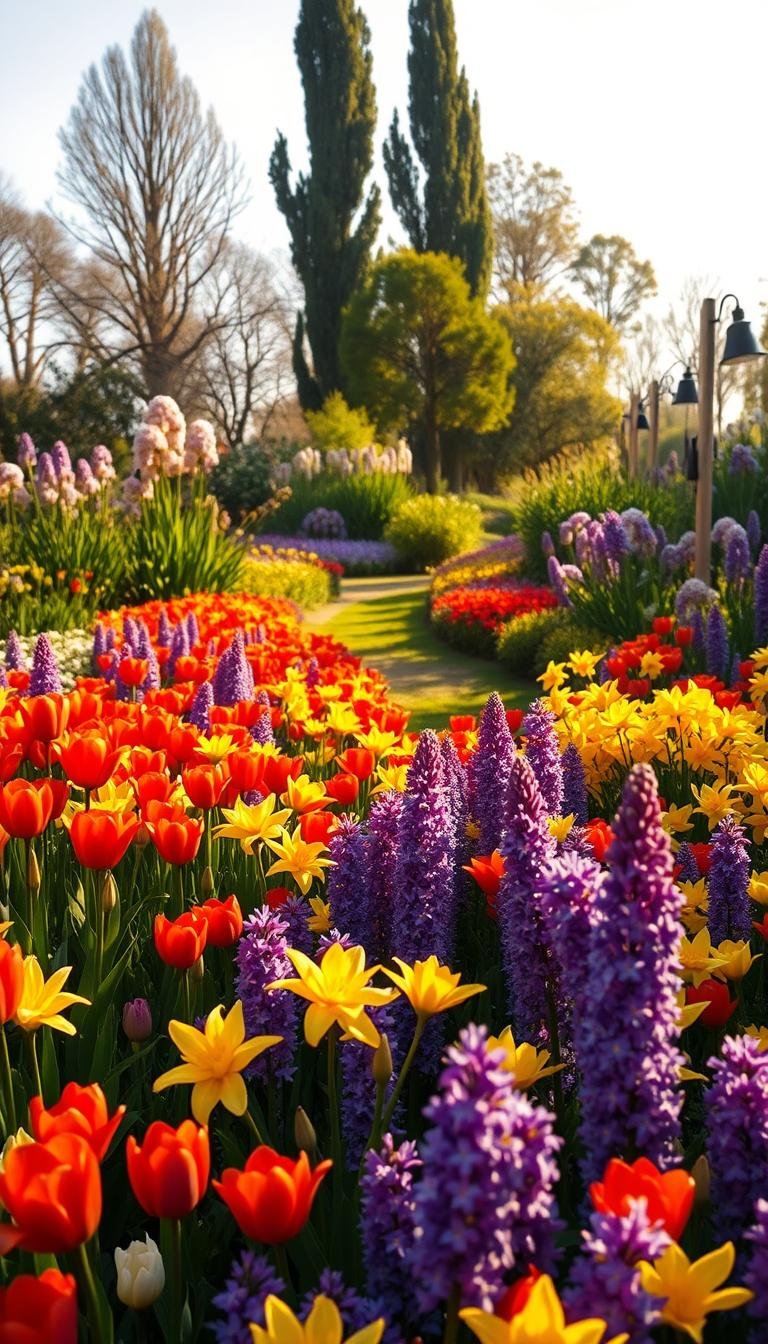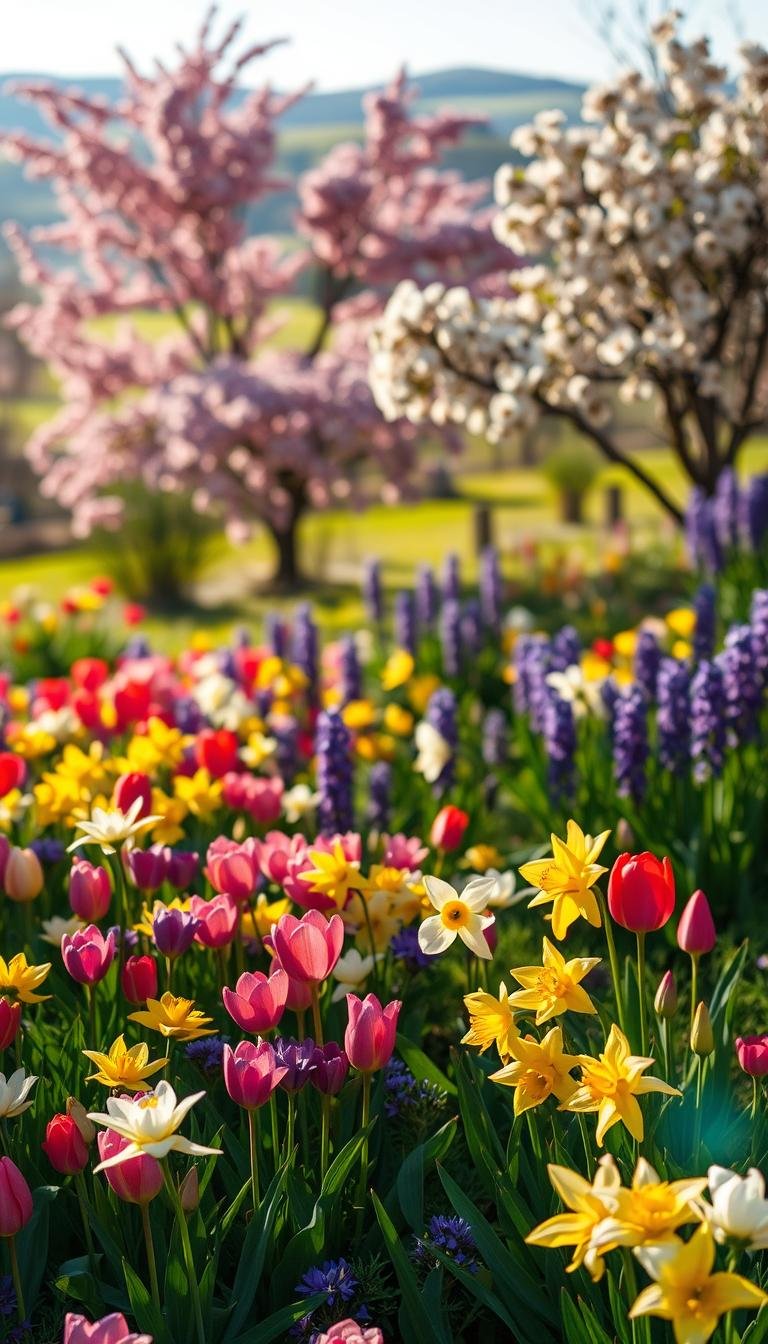This post may contain affiliate links. If you click and buy, we may earn a small commission at no extra cost to you. Learn more.
Summer Plants do more than just bloom—they bring life to any outdoor space. Whether you’re designing borders, containers, or open areas, the right choices can transform your yard into a lively oasis.
Colorful summer garden plants like sunflowers or petunias add cheer and energy. They attract pollinators and make your home inviting from every angle. These plants thrive in warm weather, ensuring months of beauty with minimal effort.
From beginner-friendly marigolds to striking coneflowers, there’s a plant for every skill level. This guide explores how vibrant summer garden plants enhance curb appeal, support ecosystems, and create spaces that inspire.
Discover how to pick the perfect varieties, care tips, and smart design ideas. Let’s turn your landscape into a summer showcase everyone will admire.
Contents
- 1 The Importance of Choosing the Right Summer Plants
- 2 Popular Summer Annuals for Instant Color
- 3 Best Summer Perennials for Long-Term Growth
- 4 The Role of Foliage in Summer Gardens
- 5 Watering and Care Tips for Summer Plants
- 6 Creating a Seasonal Garden Bed
- 7 Incorporating Edible Plants into Your Summer Garden
- 8 Seasonal Challenges for Summer Planting
- 9 Preparing Your Garden for the Off-Season
The Importance of Choosing the Right Summer Plants
Starting a summer garden means picking the right plants. These plants make your garden look great and serve a purpose. They also fit your local climate and soil, saving you time and money.
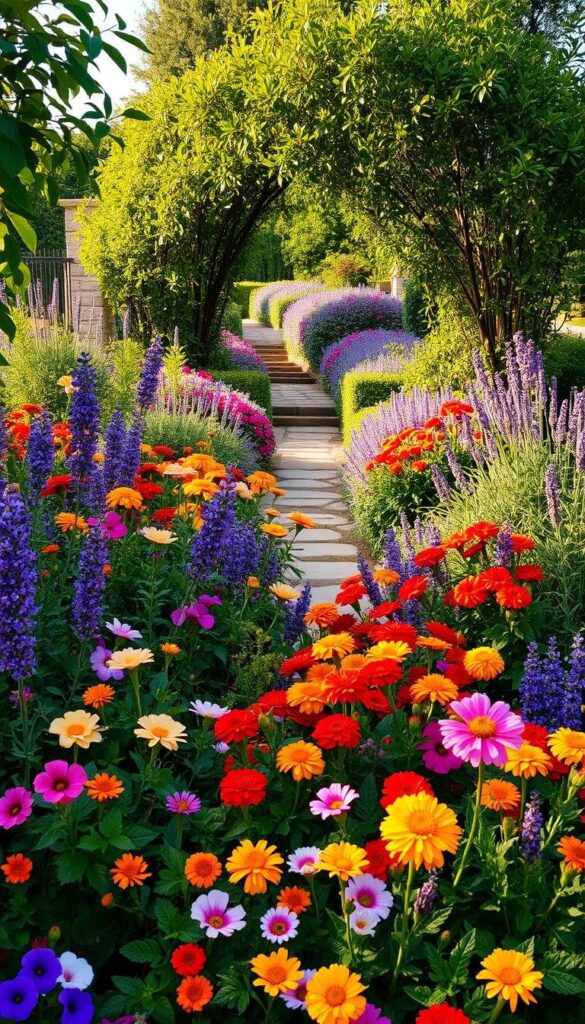
Benefits of Colorful Landscaping
Colorful plants do a lot for your garden:
- Improved mood: Bright flowers make you feel happier.
- Property value: A colorful garden can make your home look 15% more appealing.
- Memorable spaces: Mix colors like red, yellow, and purple for a lively look.
Enhancing Curb Appeal
Make your entryway stand out with colorful plants. Use trailing petunias in hanging pots or bold marigold borders. Arrange plants by height and when they bloom to lead visitors to your door.
Choose plants that don’t need much water, like lantana or geraniums. They keep your garden looking good without a lot of work.
Attracting Pollinators
Flowers attract bees, butterflies, and hummingbirds. Pick native plants like coneflowers or bee balm. These plants provide food and shelter for pollinators.
Choose plants that bloom all season. For example, milkweed is great for monarchs, and salvia attracts hummingbirds. These plants make your garden a haven for wildlife.
Popular Summer Annuals for Instant Color
Make your garden pop with summer flowers that love the heat. These plants bloom fast, adding color to your outdoor spaces. Pick from these top annuals for a vibrant, easy-care display.
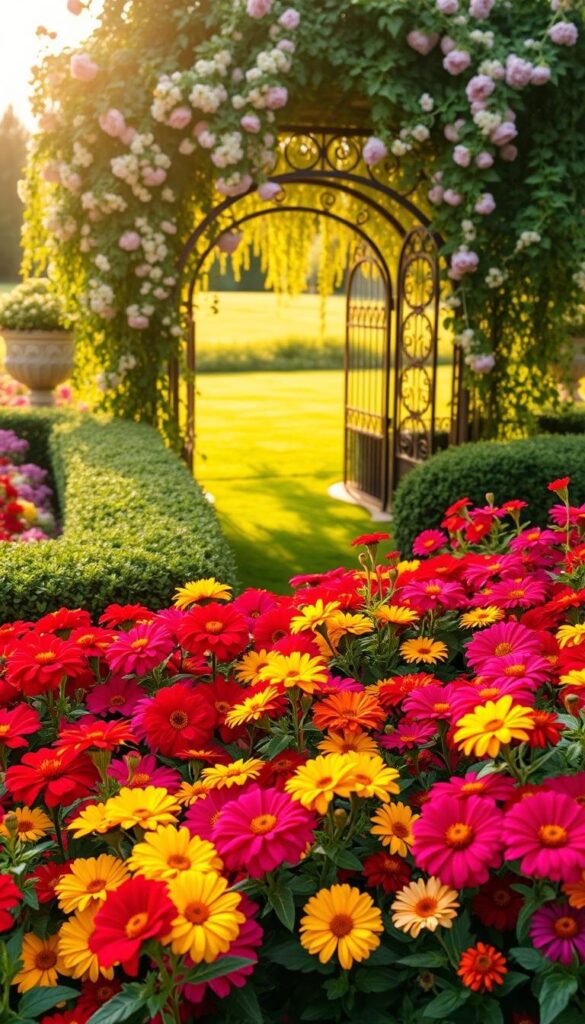
Petunias: Bold and Beautiful
Petunias bloom all season, from spring to frost. They come in big, cascading blooms in pink, red, and purple. For the best look, plant them in full sun.
They’re great in hanging baskets or as groundcover. Remember to water them often and trim them back to keep them looking good.
- Wave varieties spread 3–4 feet, perfect for edges
- Grandiflora bears 4-inch blooms, thriving in sheltered spots
- Multiflora tolerates light wind and humidity
Marigolds: Easy and Vibrant
Marigolds brighten up your garden with their golden, orange, and bicolor blooms. French marigolds keep pests away, while African types add bold colors. They grow well in poor soil and need little water.
Just pinch back the seedlings to help them grow bushy.
Sunflowers: Standing Tall in the Sun
Sunflowers come in all sizes, from 2-foot ‘Teddy Bear’ to 12-foot giants. Dwarf types fit well in pots, while the big ones attract birds. Plant seeds in spring after the frost is gone.
Make sure to rotate the plants every day to keep them facing the sun.
Best Summer Perennials for Long-Term Growth
Summer gardens flourish with perennials that grow stronger each year. These best plants for summer save time and resources. They add lasting beauty to your garden. Choose varieties that bloom reliably and adapt to changing conditions.
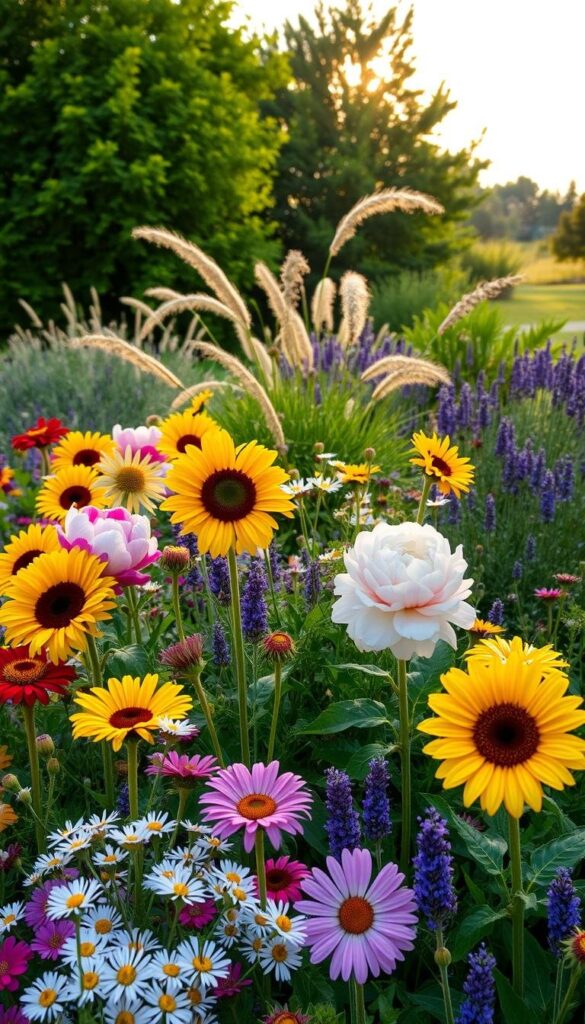
Black-Eyed Susans: Reliable Blooms
Golden petals with dark centers make black-eyed Susans a summer staple. These drought-tolerant plants spread easily, filling garden beds without constant care. Native to North America, they attract pollinators and thrive in poor soil. Plant them in clusters for bold color that lasts through August.
Coneflowers: Resilient and Lovely
Coneflowers (Echinacea) now come in shades like pink, white, and orange—not just purple. Their sturdy stems add structure even when not in bloom. Beyond beauty, their roots boost soil health, and dried flowers attract birds. Grow them in full sun for maximum disease resistance.
Daylilies: Striking Variety
With thousands of hybrids, daylilies offer blooms in every hue except true blue. Their sword-like leaves form dense clumps that outcompete weeds. Deadhead spent flowers to encourage repeat blooming. Compact varieties like ‘Stella d’Oro’ work well in small spaces.
These Summer Plants reduce replanting costs while making your garden more resilient. Mix them with annuals for layered color, ensuring vibrant displays year after year.
The Role of Foliage in Summer Gardens
Summer gardens shine when foliage is the main attraction. Leaves and grasses add structure and interest all year. Plants like ornamental grasses and variegated shrubs bring depth to any garden.
These plants keep your garden lively even when flowers are gone. They ensure your garden stays vibrant all season.
Decorative Grasses: Texture and Movement
Grasses like switchgrass (Panicum virgatum) and fountain grass (Pennisetum alopecuroides) add life to gardens. Maiden grass creates dramatic arching plumes in big spaces. For smaller yards, try ‘Hameln’ fountain grass.
Their rustling sounds and golden fall colors make them a year-round delight.
Colorful Foliage Plants: Beyond Flowers
- Coleus varieties show off red, pink, and chartreuse leaves.
- Caladium adds tropical flair with heart-shaped patterns.
- Sweet potato vine (Ipomoea batatas) trails in purple or chartreuse.
- Heuchera (coral bells) offers copper and silver leaf colors.
Pair bold-leaved plants with neutral blooms to highlight their colors. Many need less water than flowers, making them easier to care for. Mix different textures to create stunning contrasts.
Foliage is the heart of a thriving, easy-to-maintain summer garden.
Watering and Care Tips for Summer Plants
Summer’s heat is tough on plants. Learning summer plant care keeps gardens lively. These summer gardening tips make upkeep easy, saving time and water.
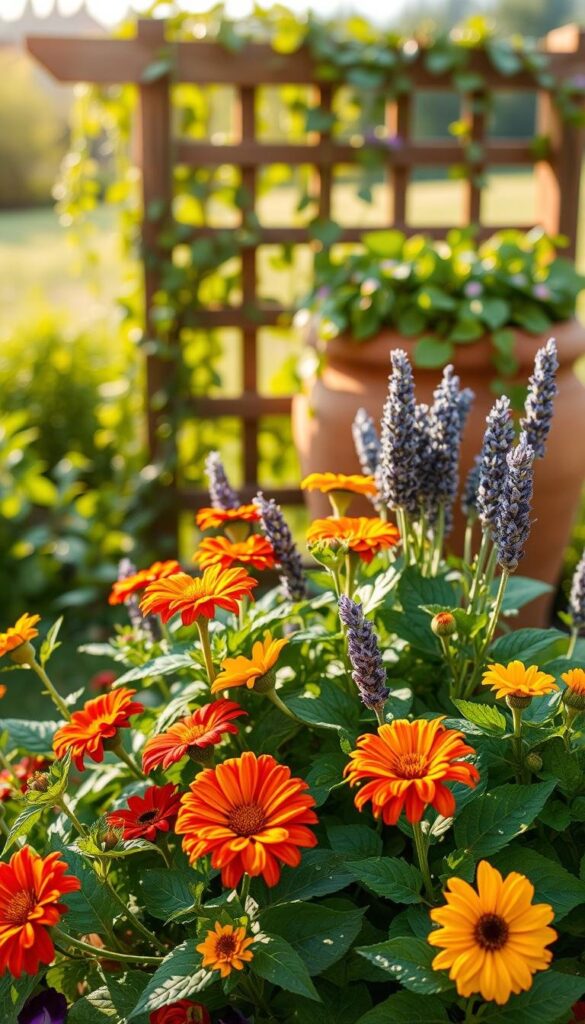
Understanding Soil Moisture
Watering right is key to avoid drowning your plants. Check soil moisture by sticking your finger in 2 inches deep. If it’s dry, it’s time to water. Watering in the morning helps prevent water loss.
Try these watering methods:
- Drip irrigation: Saves water by focusing on roots.
- Soaker hoses: Keeps soil moist with a slow release.
- Hand watering: Water at the base to avoid wet leaves.
Optimal Fertilization Schedule
Feed your plants what they need. Annuals like marigolds need monthly liquid fertilizer. Perennials, like daylilies, do well with slow-release pellets in spring. Here are some options:
- Organic: Use compost or fish emulsion for slow nutrition.
- Synthetic: Balanced NPK mixes for quick nutrients.
Pest Prevention Strategies
Catch pests early to stop damage. Common pests include aphids, beetles, and spider mites. Here are some green solutions:
- Aphids: Spray with neem oil or a strong water jet.
- Japanese Beetles: Handpick or use pheromone traps away from plants.
- Spider Mites: Rinse leaves weekly to disrupt their colonies.
Regular checks and early action keep gardens healthy. Adjust your care based on the weather for strong plants.
Creating a Seasonal Garden Bed
Designing a vibrant summer garden bed turns your space into a living canvas. Start by thinking about sunlight, soil, and space. Each choice, from bed shape to plant placement, makes your garden more beautiful.

Design Considerations for Flower Beds
Choose a sunny, well-drained spot for your garden. Round or rectangular beds are great for small spaces. Add stones or wood edging to mark the area.
Use trees or fences as natural borders. This helps anchor your design.
- Soil test: Ensure soil pH matches plant needs.
- Scale: Match bed size to your garden’s layout.
- Pathways: Leave room to walk and tend plants easily.
Layering Plants for Visual Impact
Arrange plants in tiers for visual appeal. Tall summer flowers like hibiscus or cosmos form the backdrop. Mid-height plants such as zinnias or salvia fill the middle.
Short varieties like alyssum or creeping thyme edge the front. This layering prevents overcrowding and highlights each plant’s beauty.
Companion Planting Techniques
“Pairing the right plants boosts health and color,” says Master Gardener Laura Green. “Think about scent, color, and growth habits.”
Marigolds repel pests when paired with vegetables. Basil near tomatoes improves flavor. Lavender and roses repel insects and add fragrance.
These pairings create harmony among vibrant summer garden plants while reducing maintenance.
Incorporating Edible Plants into Your Summer Garden
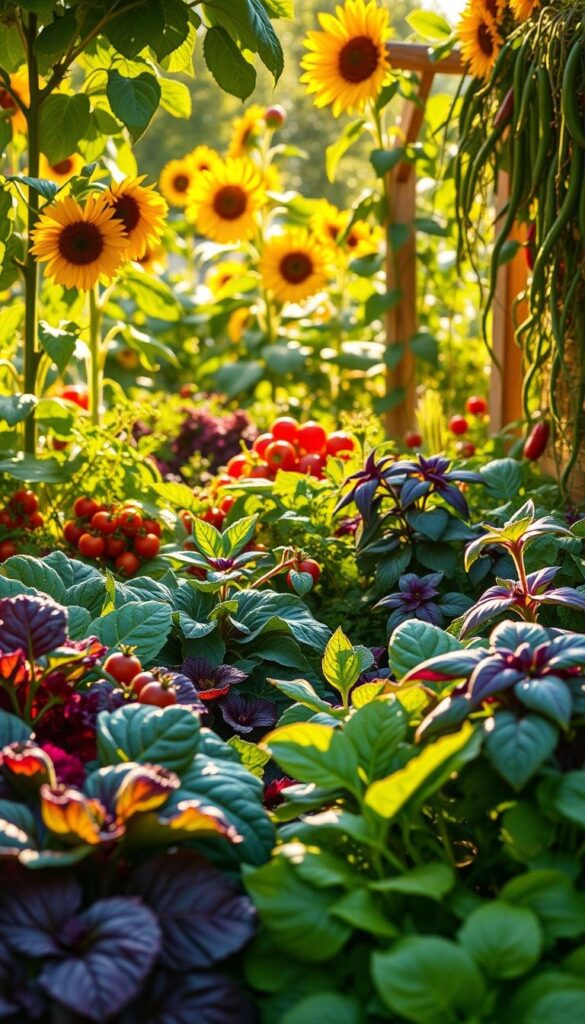
Adding edible plants to your garden makes it both beautiful and useful. Herbs and vegetables love the warm weather. They add beauty and usefulness, making them great for summer.
These plants can go in beds or containers. They use space well without losing style.
Herbs: Flavor and Fragrance
Herbs like basil, rosemary, and thyme love the sun. They add texture and smell. Their flowers also attract bees and butterflies.
Planting lavender with marigolds makes a fragrant border. It’s also good for cooking.
Vegetables: A Dual-Purpose Garden
Vegetables like rainbow chard and ornamental peppers bring color to your garden. Purple basil looks great with petunias. Flowering kale adds interest all season.
Compact tomatoes grow well vertically. They save space and look good.
Container gardens are perfect for small areas. Mix lettuces with lobelia in hanging baskets. Water herbs like they’re from the Mediterranean.
Harvest often to help them grow. This way, your garden looks good and feeds you.
Seasonal Challenges for Summer Planting
Summer gardening brings vibrant blooms but also unique hurdles. Extreme heat and pests can stress even the hardiest plants. These summer gardening tips help you tackle these issues head-on, ensuring your garden stays healthy and colorful.
Heat Stress Management
Wilting leaves and dry soil signal heat stress. Protect plants by watering deeply early in the morning. Mulch around roots to retain moisture and use shade cloths for direct sun exposure. Choose heat resistant plants like lantana, portulaca, and zinnias—they thrive where others falter. These varieties require less intervention and keep blooming through high temperatures.
Dealing with Pests and Diseases
Powdery mildew and Japanese beetles thrive in summer humidity. Prevent fungal issues by spacing plants for airflow. Treat infestations with neem oil or insecticidal soap. Remove diseased leaves promptly to stop spread. Regular inspections catch problems early, reducing damage.
- Inspect plants weekly for pests or spots
- Use organic sprays as a first line of defense
- Select disease-resistant plant varieties
A proactive approach turns challenges into opportunities. With smart choices and timely care, your garden can outlast summer’s toughest conditions.
Preparing Your Garden for the Off-Season
Summer’s flowers may be gone, but the garden work is just starting. Getting your garden ready now means next year’s blooms will be even better. Every action you take now will lead to beautiful displays later. Let’s look at how to care for your garden during this time.
Collecting Seeds for Next Year
Harvesting seeds from your favorite plants can save money and add beauty. Dry seed pods on the plant, then store them in labeled envelopes. Use a planting guide for summer to plan when to plant next spring. For a strong start, pick seeds from zinnias and cosmos by hand.
Winterizing Your Summer Plants
Keep perennials safe by cutting back dead stems but leaving some standing. This adds winter interest. Mulch around daylilies and roses with 2-3 inches to protect roots from cold. Dig up dahlia and canna bulbs, clean them, and store in peat moss in a cool, dry place.
Switch out containers for cold-tolerant plants like kale or pansies. This summer plant care routine helps your plants recover and grow stronger.
To bring you cozy inspiration more efficiently, we sometimes use AI to assist in content creation — but every word and idea is carefully shaped by our team. See our AI Disclosure for more info.


